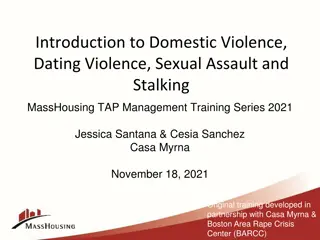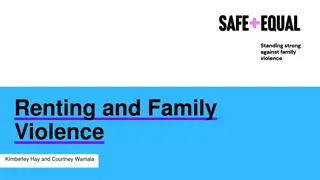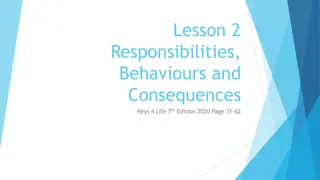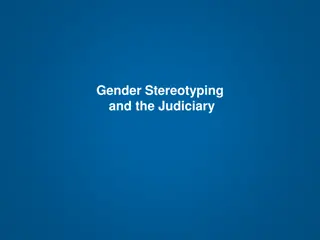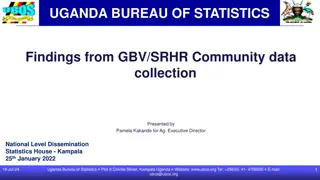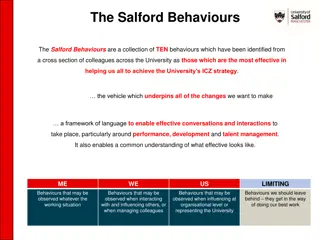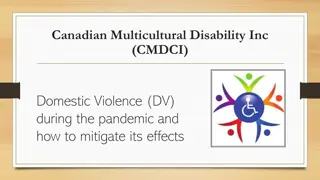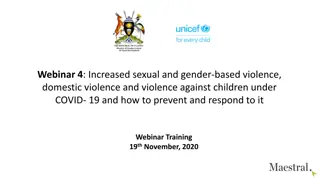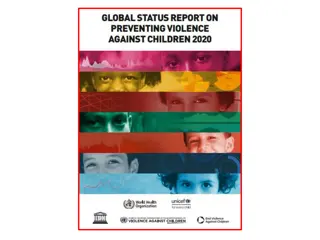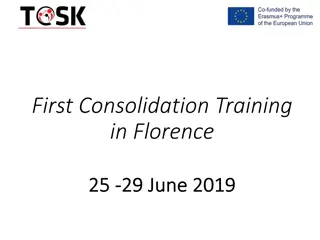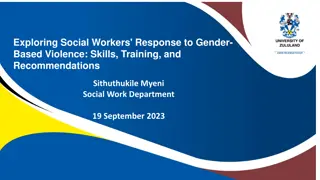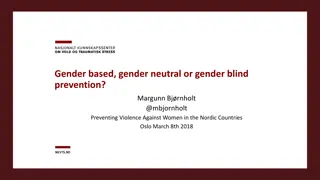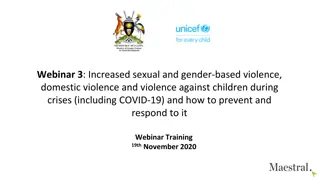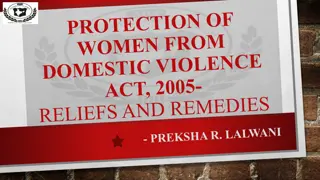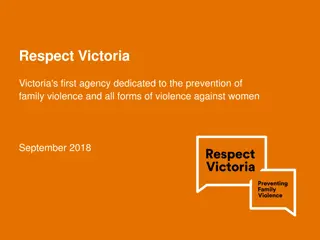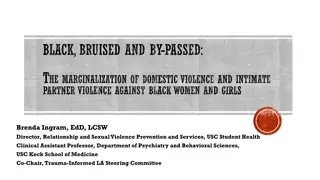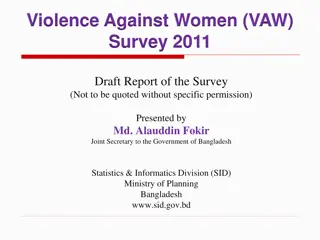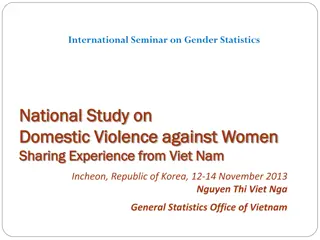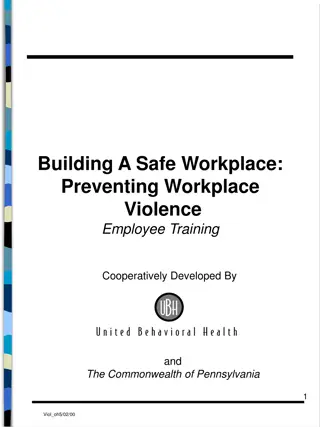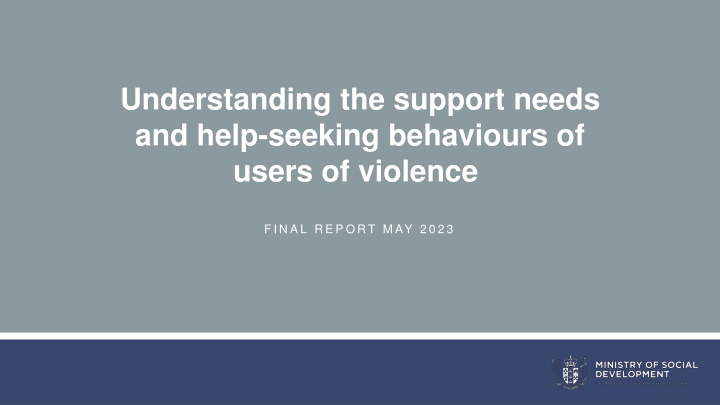
Support Needs and Help-Seeking Behaviours of Users of Violence
Explore the support needs and help-seeking behaviours of individuals engaging in violence to enhance service delivery and support systems. Uncover motivations, barriers, and solutions for accessing non-violence services and supports, aiming to prevent family violence within communities effectively.
Download Presentation

Please find below an Image/Link to download the presentation.
The content on the website is provided AS IS for your information and personal use only. It may not be sold, licensed, or shared on other websites without obtaining consent from the author. If you encounter any issues during the download, it is possible that the publisher has removed the file from their server.
You are allowed to download the files provided on this website for personal or commercial use, subject to the condition that they are used lawfully. All files are the property of their respective owners.
The content on the website is provided AS IS for your information and personal use only. It may not be sold, licensed, or shared on other websites without obtaining consent from the author.
E N D
Presentation Transcript
Understanding the support needs and help-seeking behaviours of users of violence FINAL REPORT MAY 2023
IN-CONFIDENCE 1. Research purpose and objectives 2. Methodology 3. Summary of key findings 4. The need for new approaches Contents 5. The socio cultural spaces these men inhabit 6. Stories and mindsets 7. Barriers to change what sustains their behaviour 8. Conditions for change 9. Solutions: Content and formats 2
1 Research purpose and objectives
IN-CONFIDENCE 1. Understanding support needs and current barriers to accessing support is a key component of MSD s three-year work programme to strengthen responses that support people who use family violence (FV). 2. Integrated and long-term non-violence programmes built from the perspective of service users, rather than individual service providers, offer promise for responding to FV. It appears that most research into non-violence programmes has involved studies of reoffending rates, theories of violence and subsequent development of programmes, or investigation of the perspectives of academics and health professionals. Background to this research 3. The Family Violence Death Review Committee (2020) recommended that a greater understanding of the characteristics of successful non- violence programmes is needed, including who they are most effective for and how to improve effectiveness. Furthermore, they recommend research investigating the characteristics of men who do not engage with these programmes and how they can be encouraged to. 4
IN-CONFIDENCE The Ministry of Social Development (MSD), Te Manat Whakahiato Ora, has commissioned this exploratory study of the help-seeking behaviours of people who use violence in New Zealand, particularly focusing on people who are not currently accessing Family Violence Services. Purpose of this research The aim of this research is to help identify the support needs of users of violence and assess how existing services and alternative aids could better support their clients. The Safety and Stability Team (MSD) will use this research to inform the design of family violence services, supports, and alternative aids from the perspective of users of the service (both potential and actual). 5
IN-CONFIDENCE KEY RESEARCH QUESTIONS 1. 2. 3. 4. 5. What are the motivations for and experiences of seeking help among people who have never accessed formal family violence services to change their violent behaviour? What prevents people from seeking help from, and accessing, non-violence services and support? What would encourage or make it easier for people to seek help from, and access, non-violence services and support? What types of support services (e.g., peer support, counselling) do people using violence want and need to change their violent behaviour? What else do people who use violence think could be done to support the prevention of family violence in the community? Are motivations internal or external? Availability of culturally appropriate services and supports? Lack of knowledge about what exists? Not wanting to engage? What do people using violence want help to change? (e.g., others, behaviours, attitudes) How does what people want change over time? What other types of supports do people using violence currently receive? (e.g., friends, wh nau, marae, iwi, sports groups) What other types of supports and interventions do they need, outside of what formal services may offer? (e.g., medication, sleep therapy) For people who seek and receive help, what leads them to that help or service? (e.g., only service available, came highly recommended, aligned with worldview, etc.) Who do people using violence want to turn to for support? How important is it for users of violence to receive support provided by men? And by providers who share their culture? 6
2 Methodology
IN-CONFIDENCE We used an empathy-centred research approach in our discussions with men, encouraging men to talk about their challenges with violence and abusive behaviours without judgement. "I'm nervous bro. I've never spoken about this stuff before. But I told myself I would. Usually, I find a way to get angry. I'd tell you to f*ck off and stuff like that. But I'm going to be honest. I told myself I'm going to do this. - Survival mindset Our aim with this research was to walk alongside men Our researchers prioritised rapport building and confidentiality at the beginning of discussion in order to create psychological safe spaces for men to feel that they could talk honestly and openly about their challenges. This approach led to personal disclosures among many of the men we spoke to. Some men told us that this was the first time they had talked about these instances of violence or their own personal trauma. Though we talked exclusively to men for the purposes of this study, we acknowledge that men are also subject to violence and abuse from women and from other men. These dynamics of abuse are beyond the scope of this study. 8
IN-CONFIDENCE While this empathy-led approach allows us to report back on the experiences of men who have been abusive, we need to acknowledge that this only tells one side of the story. Whilst never losing sight of the harm that abusive behaviours cause Whilst we seek to understand and explain what we heard, we must also acknowledge the harm that has been caused by the men engaged in this study and the impact it will have had on those around them who were subject to their abuse. Many of the men we spoke to were at different points of their journey of change. Whilst some men we spoke with readily acknowledged the hurt they had caused, others were less willing to do so. This report seeks to represent the perspectives of men who have used violence or abuse. Whilst we seek to understand and empathise with these men, we do not condone their actions. 9
IN-CONFIDENCE RESEARCH PROCESS The study used a five-part process to meet these research objectives. STAGE 1 FIELDWORK: EXPERIENCES AND ATTITUDES ETHICS AND PLANNING RECRUITMENT OF RESPONDENTS STAGE 2 FIELDWORK: SUPPORT NEEDS DEFINITION OF MINDSETS Completion of ethics process. Definition of recruitment approaches. One on one extended interviews comprising: Analysis of stage one fieldwork research findings. Online forum comprising: Definition of Drivers to seeking support. Agreement of individuals to participate. Definition of underlying mindsets. Life context and rapport building. Expectations and experiences of seeking support research plan and resources to support respondents and researchers. Exploring core attitudes and beliefs when it comes to relationships. Completion consent procedures. Drafting of potential support formats and positionings to include in stage two fieldwork. Ideal programme formats and needs, ways of positioning services and In Your Hands website. Exploring current and past relationships violence and abuse within the context of their relationships. Attitudes, barriers and drivers to seeking support. 10
IN-CONFIDENCE A full application was made to the MSD ethics panel before fieldwork commenced. This application covered: - Recruitment of respondents - Informed consent procedures - Disclosure procedures and limits to confidentiality, including escalation in the event of specific intention to harm. - Privacy, security and safety provisions - Access to data Ethics and planning process - Participant information sheets - Consent and support sheets Following feedback from the Ethics Committee, the research plan was finalised and resources were put in place to support respondents and researchers. The research plan, escalation procedures and interview guides were approved by the MSD project team. These documents are available on request. 11
IN-CONFIDENCE Finding respondents for the study was an iterative process and used a number of approaches. These included: 1. Recruitment from other studies: We recontacted a number of individuals who had taken part in studies around masculinity and/or family violence for Kantar Public on behalf of MSD. This included two online discussion forums exploring attitudes to harmful behaviours which were undertaken specifically with the view of recruiting people for this study. We engaged men privately and sensitively who had disclosed incidences of harmful behaviours or attitudes which condone abuse as part of these studies to see if they had interest in taking part. Seven men were recruited this way. 2. Recruitment via personal contacts: We used our networks of contacts within the sector to approach men known to them to be part of the study. Seven men were recruited this way. Recruitment of respondents 3. Recruitment via third party recruiters: We also used third party specialist recruiters to approach potential respondents from their networks. This included eight Supporters respondents and fifteen men. Before consenting to the study, all respondents were given an information sheet, and offered the opportunity for a short introduction call with the researcher if they so desired. Men who indicated that they had been mandated to attend courses for their harmful behaviours were excluded from the study. However, two men who had historically attended such courses did end up being included in the study as they had failed to declare this at the outset. Men who had voluntarily attended such courses were included. Demographic details, with the exception of age, were not sought as part of the recruitment process. Respondents ranged in age from 27 to 66. 12
IN-CONFIDENCE Respondent cohorts The study cohorts included users of violence who had never accessed services, users of violence who had accessed services, and supporters of men who were users of violence. Not accessed services Voluntarily accessed services Supporters of voluntarily accessed Mandated services n=13 n=14 n=2 n=8 Participation in: Participation in: Participation in: Participation in: Stage 1 fieldwork: Stage 1 fieldwork: Stage 1 fieldwork: Stage 2 fieldwork: Experiences and attitudes Experiences and attitudes Experiences and attitudes Support Needs One on one extended interviews One on one extended interviews One on one extended interviews Online forum Stage 2 fieldwork: Stage 2 fieldwork: Stage 2 fieldwork: Support Needs Support Needs Support Needs Online forum Online forum Online forum *This cohort were not intended to be excluded from the research. However two participants disclosed in their research interviews that they had been previously mandated to access services. 13 13
IN-CONFIDENCE Mindsets are used as a core analysis tool throughout this research. The use of mindsets is a common practice in qualitative research as a means to add nuance and holistic understanding to research findings. Mindsets are a means to bring to life otherwise abstract and complex contexts in a way that is intuitive and accessible to understand. The advantages of mindsets for this study are: 1. Empathy: Mindsets provide a way for recipients of this report to gain a deeper understanding for the lived experience of the people who took part in the research. By presenting mindsets this way, we hope that the reader of the report will gain a deeper and more intuitive understanding of the needs, motivations and behaviours of each specific group. The use of mindsets 2. Programme development guidance: Mindsets can aid in the development and design of support services by helping decision makers build programmes based on their holistic understanding of the mindsets. Our intention is that stakeholders will find these of assistance in making informed and targeted decisions throughout the design of these services. 3. Targeting: the use of mindsets can provide valuable insight as a means of identifying unique characteristics, motivations, preferences and pain points for diverse audiences and needs, with a view to using these as a means to encourage more people to seek support. The mindsets outlined in this study have been drawn from analysis of the responses of the participants and have not been cross referenced with findings or frameworks from other studies as this was beyond the commissioned scope of this study. 14
IN-CONFIDENCE The mindsets were drafted after the first stage of fieldwork and refined after the second. They were constructed by: 1. Capturing the detail of responses from each individual for: Features of their background, family relationships and role models. Features of their relationships patterns, behaviours, description of partners Triggers and types of abuse disclosed context and content of abuse Personal insecurities and challenges self talk, identity and feelings about self 2. These responses were then analysed, and key themes identified around their world view and their attitude to violence/abuse. These themes were used to sketch out the different mindsets. 3. Each individual s responses were then compared against these different mindsets, and individuals allocated to potential mindset/s. The mindsets were also refined during this process of comparison with each individual s set of responses. Defining the mindsets 4. The respondents were then grouped by mindset/s and their responses to discussions. These included: Current pathways to change Triggers, facilitators, barriers and offramps Practical and emotional needs Formats and non-negotiables 5. For each mindset identified, repeated ideas and stated preferences were analysed to draft ideas for potential needs and solutions. These were captured as part of the stage one download of findings with the project team. 6. These were used as the inspiration for potential support positionings (motivations and needs) were which ideated with the project team. These were included in the second stage of fieldwork to spark response, and responses analysed to identify ideal support services for each mindset. The mindsets were evenly split across the sample, with approximately one third in each mindset (Survival n=10, Caged n=9, Insecure n=8. Uncategorised n=2). However, as noted in the study limitations, we cannot project whether the sample are indicative of the wider population. 15
IN-CONFIDENCE The particular focus of this study (men who have abusive behaviours, with a focus on those not currently accessing family violence services) means that the key challenge for the study was finding respondents who were willing to take part. This has a direct impact on the limitations of the study: 1. Self selection: All the men were aware of the subject matter before signing up. As a result, the sample reflects those who were willing to talk about their harmful behaviours. We cannot say whether these men are representative of the broader population of men who have harmful behaviours. 2. Diversity: Because of the difficulty in engaging participants to be part of the study, the recruitment process did not employ demographic quotas. The cohort of men we talked to included respondents who were M ori and Pasifika (as well as other ethnicities) but we have refrained from analysing their responses in isolation as we cannot be sure that their responses are more broadly representative of M ori and Pasifika viewpoints and experiences. The exception to this is the need for culturally safe support services (described here) as this was a clear need amongst these respondents. Other differences (of experience, need or mindset) were less evident and have not been reported. Study limitations 3. Demographic details: We had high levels of anonymity in order to give respondents the reassurance they needed to take part. This meant we did not seek the personal details of respondents (e.g. location, job, ethnicity) and therefore cannot provide a demographic breakdown of the sample. 4. Limitations of their accounts: We heard the men s side of the accounts about their relationships and did not seek to include their partner s or wh nau perspectives (for reasons of privacy, safety and scope). 5. Limitations of behaviours: We sought to engage men around behaviours which included not just physical violence, but emotional abuse and coercive control. However, respondents in this study may well have been subject to the widespread tendency to more readily identify with instances of physical harm than other types of harm. 6. Limitations of mindsets: We acknowledge that the use of mindsets is reductive by necessity, and can never reflect the complex, changing and context-dependent nature of individuals. We use them here as a tool to aid analysis and understanding. 16
3 Summary of key findings
IN-CONFIDENCE Across the diverse life stories of the respondents, many men spoke of a sense of disconnection, inadequacy, unresolved hurt and embattlement. However, across the diversity of respondents, three quite different mindsets ( Survival , Caged and Insecure ) seem to be present. These three mindsets appear to have different socio-cultural influences, needs and patterns of behaviour that have an impact on how they engage with support services. For the Survival mindset, violence is often bound up with other parts of their life and their conception of self. The Caged mindset often have firm masculine values and struggle to reconcile these values with their behaviours. The Insecure mindset seek validation and have a tendency see others as the source of their issues. Summary mindsets and motivations There are many presumptions about current services for stopping violence. Shame, safety, social exposure, judgement, and irrelevance (not needing or not meeting their needs) can deflect individuals from approaching these services. Many perceive them as not for them . The motivation to change behaviour is multifaceted. Our respondents typically described a sense of deep dissatisfaction with their life, a rock bottom moment and the timely appearance of an alternative - a moment of grace . These conditions create a window of opportunity which can be quite fleeting. Underlying these motivations is a deeper desire for growth a greater focus than merely moving beyond their harmful behaviour, and for some, the desire to give back . This internally driven motivation may be more sustainable in the long term than externally driven motivations. 18
IN-CONFIDENCE Given the different 'spaces' that each of the mindsets occupy, the formats and contents of support services do vary accordingly. There is no one size fits all with content, messaging and formats varying across different mindsets and stages. However, there are some commonalities, such as a warm, welcoming, judgement-free environment, away from potential triggers. There is anticipation of a blend of delivery methods, responding to different needs such as escalation, information, and connection. Meeting with other men going through similar challenges is welcomed by many. Summary support needs The right facilitator is crucial. This person needs to be able to authentically connect with these men and has a disproportionate impact on their perceptions of the experience. Culture plays a strong part in facilitating people's sense of connection and a sense of belonging and is particularly important for those who are M ori or Pasifika. The In Your Hands website is warmly received and looks like it has potential to connect strongly with these men. 19
4 The need for new approaches
IN-CONFIDENCE The prevalence of intimate partner violence (IPV), the severity of adverse consequences experienced by its victims, an over-reliance on mandated treatment through the criminal justice system to interrupt ongoing IPV, the modest outcomes of treatment programs for partner abusers, and the relatively high attrition rates from these programs all converge to require that high priority be given to intervention research in this field. N E I G H B O R S , WAL K E R , R O F F M AN AN D M B I L I N Y I 21 21 CLAYTON NEIGHBORS, DENISE D. WALKER, ROGER A. ROFFMAN, and LYUNGAI F.MBILINYI Self-Determination Theory and Motivational Interviewing: Complementary Models to Elicit Voluntary Engagement by Partner-Abusive Men. University of Washington 2008
IN-CONFIDENCE A key element of our society's efforts to address family violence is the use of mandated programmes for people who have been cautioned or convicted of family violence. From mandating to motivating individuals to address their behaviours However, there are also those people whose behaviour may be harming others but who are not currently picked up by mandated programmes. This research concerns itself with how to reach out and connect with these 'men in the middle'. "The question we need to ask is 'Why is he doing it and why doesn't he stop?" And what can we do as a society to prevent this from happening in the first place? These are the men that we want to encourage to address their behaviours from their own volition. This is part of the strategy of moving the paradigm of our societal response from approaches that mandate individuals, to approaches that motivate individuals to address their behaviour. Deeyah Khan "Behind the Rage" Throughout this report we seek to understand how men conceive and explain their own use of violence, to better understand what might motivate men to seek help and support for their violent and abusive behaviours. 22
5 The socio cultural spaces these men inhabit
IN-CONFIDENCE It has long been recognised that the causes and influences of violence and abuse are complex, as has been extensively covered in the literature on the subject, both in New Zealand and further afield. This is not the focus of this study. However, taken as a whole, the stories we heard from our participants reflected distinctive patterns of lifestyles and influences, which appeared to be connected to how they viewed themselves and their behaviours. We detected three different socio-cultural spaces , each with their own influences, social mores, cultural currents, and patterns of violence/abuse. These were drawn from the conversations, the accounts of life experiences and the language used by participants when describing their situation. Understanding the socio-cultural spaces that these men inhabit We call these three spaces 'Lifestyle', 'Ideals' and 'Deflective . No doubt these spaces overlap and influence one another, but also seem distinct enough to have their own sets of associations. We suspect these three spaces run deeply: influencing the behaviours and the attitudes shared by our respondents. We speculate that they may also be influential in how we, as a society, view and address the problem of violent and abusive behaviours, specifically amongst men. It should be noted that these socio-cultural spaces are speculative, and we include them here as context for more deeply understanding mindsets and needs, which we address later in this report. 24
IN-CONFIDENCE THE THREE SPACES WE DETECTED IN OUR CONVERSATIONS Ideals space Deflective space Lifestyle space Family violence associated with male ideals of strength, respect and entitlement Family violence associated with ideas around male self- victimisation Family violence associated with violent habits and lifestyles 25
IN-CONFIDENCE I can't see that being kind and generous is good. I still see it as being weak. You might get hurt. I'd use my aggression to get my way. I can be controlling. I need to get my own way. How the I'm an evil person that can't be fixed. Lifestyle space I never knew what feelings were. I learnt it's OK to be angry. It's what you do with the anger. feels It's a cultural thing to be tough. That's how you show you're masculine, like, 'I can be violent, let me show you . To be anti-violence is dangerous. I almost looked forward to the trigger. Like it means I can bash my dog, or punch the police. You seek rejection because you're a reject. 26
IN-CONFIDENCE It is me against the world." We are both reasonable but both quickly went to violence. Mid way through I had this realisation of what the f*ck? How did we get to this? How the I took it out on my son, I was angry because he wasn't what I expected him to be." Ideals space feels My expectations for myself and for my family were high. If they got it wrong, I d just loose it at them. I'd be like 'harden up man, what good is talking? I always thought to myself I will not become that man (my father) . But I did. I became a different version of him. 27
IN-CONFIDENCE There's a societal pressure to not act like that against your partner. I like expressing feelings, but men aren't allowed to do that. How the I know what I need I just need to meditate for 7 hours solid, to transmute the pain. Deflective Men are like asexual jelly fish, not useful to society. Their value is lower, until their manliness is needed. space I get triggered, and I start swearing, like 'f*ck you b*tch, f*ck you, leave me alone'. feels "I am easily triggered by lying and I am really good at knowing when others are lying. It's not long before a good person loses their sh*t. It s when I have the feeling of no control. Like, I realise that the emotion of the situation is out of control. I've never gone out of my way to assault or physically attack. 28
IN-CONFIDENCE CHARACTERISTICS OF THREE SPACES: How the dialogue differed across our conversations Lifestyle Space Ideals Space Deflective Space Compunction Gratification Embattlement Resentment Victimhood Insecurity Violence/abuse rationalised via survival Violence/abuse rationalised via pressure Violence/abuse rationalised via provocation In the "Ideals" space, we encountered feelings of embattlement and resentment around the stresses of life and an underappreciation of the male role, particularly as a provider. In the "Deflective" space, we encountered feelings of victimhood and insecurity (including jealousy) both personally and as a feature of their relationships. In the "Lifestyle" space, we encountered feelings of compunction and gratification - that violence is often a necessity, and may also be satisfying. We heard reasons given for violence/abuse as being a requirement for success or survival in their world. We heard reasons given for violence/abuse as a response to provocations from their partner. We heard reasons given for violence/abuse as a response to a buildup of pressure. We saw that their stories rarely connected their behaviour to their own personal causes though we inferred connections with low self- esteem and narcissistic tendencies. We heard stories that connected this reasoning to influences around subcultures (e.g., gangs) and upbringing which has molded certain attitudes and instincts around violence, loyalty and power. We heard stories that connected this behaviour to cultural and social norms around the importance of strength, capability and respect as a man. 29
IN-CONFIDENCE CULTURAL CURRENTS: How we might speculate that these conversations reflect broader cultural currents Lifestyle Space Ideals Space Deflective Space Enduring Dominant/receding Emerging Family violence associated with violent habits and lifestyles Family violence associated with male ideals of strength, respect and entitlement Family violence associated with ideas around male self-victimisation Perceptions of 'gang culture' and 'wife beaters' have long been associated in the public mind with family violence. Indeed, we might speculate that for many in society, this dominates their perceptions and beliefs around family violence. This space could well be fueled by cultural and social norms around masculinity which particularly influence perceptions of the roles of partners and fathers. Though this type of perpetration is not new, we suspect that it is being given fresh impetus from global narratives around 'gender wars' (which legitimize male victimization), the ascendency of conspiracy theories and the adoption of fringe philosophies which featured in the conversations with this group of men. As a society, we seem to be re-evaluating many of these norms. This type of family violence, in particular, may well increasingly be seen as a source of stigma and shame. The 'shaming' (and atonement) of perpetrators may well be the main way as a society that we respond to this type of violence. As a society, our instincts to deal with this type of perpetration could well be shaped by the desire for punitive measures, that also have the effect of creating distance from the issue. As a society, we speculate that we currently do not have many mental or practical frameworks for dealing with this type of perpetration. 30
6 Stories and mindsets
IN-CONFIDENCE WHO WE MET This section concerns itself with the men's stories we heard, in order to help understand what's going on in their mind that's leading them to harm others. We met a diverse range of 'men at the bottom of the stairs' - some in denial, some curious about change and some battling their way through it. These individuals all had their own stories, and their own reasons (or excuses) why their behaviour was harming those around them. They included those with extreme histories of violence, to those who had claimed never to have laid a hand on someone but admitted to controlling behaviours and verbal abuse. They ranged from respectable retirees to young guys recently out of the care system, and from those who lived a life where physical violence is normalised, to others who claimed not to have laid hands on anyone. Markedly, all respondents were incredibly receptive when engaged in the right conversation. For some, there may have been some initial difficultly in opening up, but the relief once doing so was palpable. 32
IN-CONFIDENCE Among the most violent people, the most hardened guys, the most respect I ever got from them, is when we've talked. L I F E S T Y L E M I N D S E T 33 33
IN-CONFIDENCE AMONGST THEIR DIVERSITY, THERE WERE SOME COMMONALITIES THAT EMERGED: Unresolved hurt Disconnection Inadequacy Embattlement 34
IN-CONFIDENCE A crisis of disconnection Growing up, I didn't feel like I belonged in my wh nau. I never felt like I belonged. I remember feeling deep down, like I didn't belong, no one wanted me. these men seemed lost to themselves, to others, and to society. They were often profoundly lonely, even if they were outwardly social. Few spoke of having close relationships in their life and many lacked good role models around them. 35
IN-CONFIDENCE Sense of inadequacy these men were often estranged from themselves and who they desired to be. With the curtains drawn (literally and figuratively) this low sense of self-worth had different levels of pervasiveness for the men, but almost all disclosed feeling inadequate or unworthy. The self-talk can get really bad. It s stuff like I m a piece of sh*t . The world is f*cked. 36
IN-CONFIDENCE Unresolved hurt "I was adopted I don't know why my parents abandoned me. All my problems have been about rejection. You seek rejections, because you re a reject. Your own parents couldn t be bothered raising you. I ve never understood how they could do that to me. -they were often discombobulated from trauma -including sexual, physical and/or emotional abuse, and/or neglect. They often discussed these as being unresolved, and see this unresolvedness as the cause of multiple struggles they have experienced in their life. 37
IN-CONFIDENCE Embattled lives "I don't know what problem to fix first. It s like I'm sitting in the bath. And I ve got all these taps, they re all on at the same time. I don t know which problem to fix first. What tap do I turn off? Is it the job, do I step back from the kids, work on my relationship with my parents? they often had a sense of being dealt the wrong cards and were dealing with multiple stresses including mental health issues, drug and alcohol addictions and poverty. Many men discussed needing to prioritise one issue over another. 38
IN-CONFIDENCE Across their commonalities and all their differences, three mindsets emerged that reflect three socio-cultural spaces: Deflective space Deflective space Ideals space Ideals space Lifestyle space Family violence associated with male ideals of strength, respect and entitlement Family violence associated with ideas around male self- victimisation Family violence associated with male ideals of strength, respect and entitlement Family violence associated with ideas around male self-victimisation Family violence associated with violent habits and lifestyles THE SURVIVAL MINDSET THE CAGED MINDSET THE INSECURE MINDSET Craig s story David s story William s Story 39
IN-CONFIDENCE You get dealt the wrong cards. f*ck it. Why me? I ve got to deal with what I ve got. I N S E C U R E M I N D S E T 40 40
IN-CONFIDENCE Using violence has been something that has been part of David's life since he was young. He has spent time in prison for serious assaults, and he was introduced to drugs and alcohol at a young age by his father when he was young. David talks about how, for most of his life, he fully embraced the 'gangster' lifestyle. He says that he will often look for excuses to get angry and use violence. "I get really angry. In that moment I even forget what I got angry about. I just want to get angry . In his younger years he thought it was 'cool' and looked up to the guys in the gangs. "I was trying to be a gangster, getting flash cars, getting flash things, chasing stacks of paper. I was chasing a dream. Chasing an idea of what I thought was cool. It took me a long time to realise that my way didn't work. The Survival Mindset: He describes how he spent a long time depressed and lost what he describes as staying at home with the curtains drawn. "I just thought I was an evil person, that I couldn't be fixed. David describes his life as being all about survival. In this world, showing kindness towards a partner and children can make you a laughing stock , or worse, a target. He says that using violence against a partner is considered normal and even expected. "In that world, to say you are anti-violence is dangerous. People will take your shoes, your belongings. It's the law of the jungle. In that world you are meant to be smacking your partners and your kids around." David s Story David describes how showing kindness and love in that world will make you look weak and make you a potential target. He still sees vulnerability and kindness as a big risk. "I still can't see that being kind and generous is good sometimes. I still see it as being weak. Like, it's a big risk, you might get hurt. At first the violence was directed at other men but is says it leaked into his intimate relationships. "That violence and attitude that 'I'm the man' floats into your whole life. You can't segment it". David described that he would often enjoy losing control. "It is an excuse, like being able to say 'Forgive me, it wasn't me, I lost it'. There is a sense of indemnity when you get to that point of seeing red. It's like, 'I must have been temporarily insane .He says that afterward, he would often feel humiliated and embarrassed. 41 41
IN-CONFIDENCE THE SURVIVAL MINDSET: COMMON CONTEXT Those in the Survival mindset often experienced violence or severe feelings of neglect or abandonment as children. Respondents in this mindset often had a history of drug and alcohol use and described being surrounded by (in their words) bad people . "I felt like a waste of space. It took other people walking away from me to hit rock bottom." - Survival mindset Those in this mindset had relationships that are often extremely volatile. They may have a casual approach to violence - violence is usually normalised and can be used as a tool to get what they want. There seemed to be very little respect or empathy shown towards their partners. They often reported severe and frequent violence, of both a physical and emotional nature. "If she didn't do what I said, I'd give her a hiding. It was the easiest way to what my way. I thought violence was normal. My dad hit me; it was a way to get control." - Survival mindset A number of respondents admitted to enjoying violence and some in this mindset talked about looking for excuses to be violent. They sometimes see violence as a legitimate way to punish partners for perceived indiscretions. "I was adopted. My adoptive parents were awesome, but I grew up angry and was aggressive to them. I didn't know why I was rejected (by birth parents). I felt like I didn t deserve to be cured ". - Survival mindset 42
IN-CONFIDENCE THE SURVIVAL MINDSET: INSIDE THEIR HEADS People in this mindset believed that respect is gained through staunchness and violence, and that any kind of vulnerability is unsafe, both emotionally and practically. Weakness is something that will be taken advantage of by others. They believe that men should be tough, powerful, uncompromising, and will go to great lengths to prove they have these qualities usually through using, or threatening to use, violence. It took me 25 years to understand the harm I was doing to my kids. I saw the harm I was doing, but I didn't really care. I knew nothing about feelings. I met a counselor, and he taught me what the kids might be feeling. I had no f*cking idea. Survival mindset They saw violence as necessary to survive in the world. Some saw their anger as an inherent part of who they are that can't be fixed only contained. My father is very closed to explaining his emotions, I don't think I've ever heard him do it. He was always thinking that he doesn't need this type of help, the 'macho man'. Survival mindset (supporter) 43
IN-CONFIDENCE My expectations for myself and for my family were high. If they got it wrong, I d just loose it at them. C AG E D M I N D S E T 44 44
IN-CONFIDENCE Craig describes his father as a physically and emotionally abusive alcoholic, who expected everyone else to meet his needs. "He was very abusive. It was his way or the highway. He expected us to wait on him. My mum would work three jobs, but Dad would do nothing. He was a patriarch, he expected the kids to make him breakfast, and do whatever he needed." Craig describes how he never wanted to be like his father. "I always thought to myself, 'I will not become that man'. But I did. I just became another version of him. I didn't use my fists, but I knew how to hurt people." The Caged Mindset: While Craig carries some resentment toward his father, he talks about him with a degree of respect and admiration. He enjoyed the bond they had and describes how his father always pushed him and supported him in his sporting pursuits. Sam remembers as a young boy wanting to make him proud, and how much getting his dad's approval meant to him. "Even though he was an angry man, when I succeeded, it made him happy. I wanted to win (at sports) because I knew it would make him happy. I had the ultimate belief that I could f*cking beat anyone and make him proud." Craig s Story When Craig's Dad died, he says he had a choice for the first time. "I could do what I wanted to do. I went down a bad path. I started stealing and smoking." In some ways he believes he needed his Dad's discipline and guidance in order to stay out of trouble. He says that he blamed his father's death for the situation he found himself in for years. He says "I never owned that I had a choice in where I ended up. I just blamed my dad dying for years." Sam describes his challenge with violence as predominately verbal abuse toward his wife and his children, and that he had also been physically abusive on two occasions. "I know how to hurt people with words, I know the right things to say to hurt people emotionally. I put them down. I talk to them in a demeaning manner." 45 45
IN-CONFIDENCE THE CAGED MINDSET: COMMON CONTEXT Those in the 'Caged' mindset had often grown up in 'tough love' environments. They reported both fearing and respecting their fathers, and they often had a sense of living out their father's flawed legacy. Many in this mindset described going through a process of understanding and forgiving their father in order to overcome him. The Caged seem to believe there is a right and a wrong way to be a man. They seem likely to buy into more traditional notions of masculinity, and above all want to be seen as strong, capable and in control. They highly value having respect and acceptance from other men (and sometimes sought reassurance of this from the researchers). They admitted that they generally will avoid situations and conversations that make them feel vulnerable. My idea of manhood comes from the men in my family and in my community. It was that regional 80 s version of what it is to be a man. You didn t talk much, you just needed to harden the f*ck up. We got tough love at times, kicks up the bum, that sort of thing. - Caged Mindset Many had had a rebellious youth, including going through a stage of using drugs, sleeping around and getting into fights (with other men). They often have a (to their minds) 'respectable lifestyle now. I went through a journey to forgive my father and my grandfather (for the violence). I realized they wanted the best for their families. The violence was usually an explosion of anger. It wasn t premeditated. - Caged mindset The family unit seems to be important to them. Many echoed beliefs that they have a responsibility to be a strong, staunch provider and protector. They often had high (and sometimes unrealistic) expectations of themselves in this role. To their minds, abuse can be perceived as reactionary due to what they experience as a lack of respect or appreciation for their efforts. They may also resent that others in the family unit aren't playing the role that the Caged mindset expects of them. Incidents were often described as starting with verbal abuse and sometimes escalating to physical abuse. This seemed to be sporadic at first, but then built up over time. 46
IN-CONFIDENCE THE CAGED MINDSET: INSIDE THEIR HEADS It seemed that failing to live up to the standards they have set for themselves can be a strong source of shame. They seemed to resent and blame others around them for these perceived failings if they aren't living up to their own roles. Deep down, they admitted to fears of being alone and unwanted, but seemed reluctant to admit this to themselves. They seemed to exhibit a preference to 'get on with it' than admit to any personal insecurities or perceived failings. In their own words, they felt stuck . Some talked about feeling numb and their soul empty - and used alcohol, work or sex to avoid emotions that made them feel uncomfortable. I realized I needed help, but I didn t know where to go. I recognized that there is a present, continuing, angry part of me that is part of who I am. - Caged mindset As the provider, they often saw themselves as selfless, sacrificing their own needs and putting others first. They often implicitly considered themselves to be the centre of their family unit. This was usually coupled with an underlying resentment that their sacrifice isn't appreciated. I was blind to what I was causing. I was blaming other people for what was happening. I tried to make it all about me. - Caged Mindset They often become more aware of their behaviour once they have children for many, not wanting to become their fathers looms large in their minds. The effect of their behaviour on their children was often be the catalyst for change. Rather than seeing anger as something to overcome, they saw anger as something to be controlled. They saw anger as part of who they are (for better or worse), and may have come up with strategies to limit triggers in their environment. However, they did not consider themselves to be violent men. 47
IN-CONFIDENCE Love bombing at the start which turned into controlling behaviours, put downs, verbal abuse, gas lighting.... I saw beautiful girls turn into shadows of themselves appearing to seek approval for how to think, what to say and what to wear from my friend. And nothing was ever his fault. He opened up that he was experiencing anger issues. He felt low confidence, anxiety and depression. I N S E C U R E M I N D S E T S U P P O R T E R 48 48
IN-CONFIDENCE William has been in a number of volatile relationships some with abuse and some not. He believes this is proof that anger doesn't lie within him, because "I've been in good relationships in the past, and all her relationships have been toxic." The Insecure Mindset: William believes he isn't an 'angry person', despite his history. He goes to great lengths to demonstrate his 'goodness'. "I've got a good heart. But I struggle with things". He will justify his anger and abuse as a reaction to a perceived provocation from his partner. He often talks about her issues, and her need for professional help. He thinks that using violence is 'bad', but will blame his partner for provoking anger in him. "I'm not an angry person, if someone comes at me with anger, I'll react with anger. I'll just lose it. When I think about it, I think wow, she must be so bad to bring that kind of behaviour out in me." William s Story He describes his current relationship (and some others in his past) as "f*cking chaos". He talks about experiencing excessive jealousy and insecurity, particularly about his current partner's number of sexual relationships. "For the first year, it was all about asking her how many people she's f*cked. It was always, 'how many people have you f*cked, how many people have you f*cked.' She wouldn't tell me." He talks about how he feels like there is pressure from women to be the "strong stoic silent type" and that "men are expected to hold their emotions in" which he feels is an unrealistic pressure that women put on men. 49 49
IN-CONFIDENCE THE INSECURE MINDSET: COMMON CONTEXT Those in the 'Insecure' mindset can come across as quite conflicted and contradictory. On the one hand, they often have a sense of self-aggrandizement, and (on the surface at least) a sense of being smarter, or better than other people. They seem to enjoy information that feeds this sense of self, and may spend a lot of time online reading articles and watching clips on niche topics such as conspiracies. "We were in a drama triangle all the time. I never knew in the morning what could happen. I must have subconsciously liked that, like it gave me a short-term excitement fix." - Insecure mindset On the other hand, they often talk of feeling misunderstood and appear resentful and lost, with no clear sense of identity. They seemed to be often lonely and disconnected from others. Few mentioned close or fulfilling friendships. A few mentioned bullying and lack of relationship role models in their pasts. When they find a bond with someone and form a relationship, they often seem to cling to it and look for attention and reassurance. They often had a long history of volatile relationships, in which excessive jealously was common. "I slapped her once when we were driving from England to Turkey, she was trying to jump out of the car, so I slapped her to calm her down." - Insecure mindset Those who had the 'Insecure' mindset seemed to have incidents of violence and abuse where they perceived themselves to be victimised or got at/wound up/put down in some way. They constantly deflected blame away from themselves and onto their partners. They may feel that if they have an emotional reaction to something, they feel impelled to run with it. They often seem to push for immediate resolution of an argument. They justified their own behaviour by blaming their partner for a perceived provocation or character flaw often this involves referencing a partner's sexual history, or her past relationships. They often attempted to convey that they had no choice. "When women are playing games with me, I feel like I am losing my sh*t and I need to take control back. Using manipulation tactics got results." - Insecure mindset Violence usually consisted of verbal abuse, sometimes escalating to physical outbursts. Verbal abuse will consist of name calling and using someone's history to put them down. Manipulation and control (from both sides of the relationship) was often mentioned. Sometimes violence is framed as 'being for their own good' or to 'protect them from themselves.' 50

